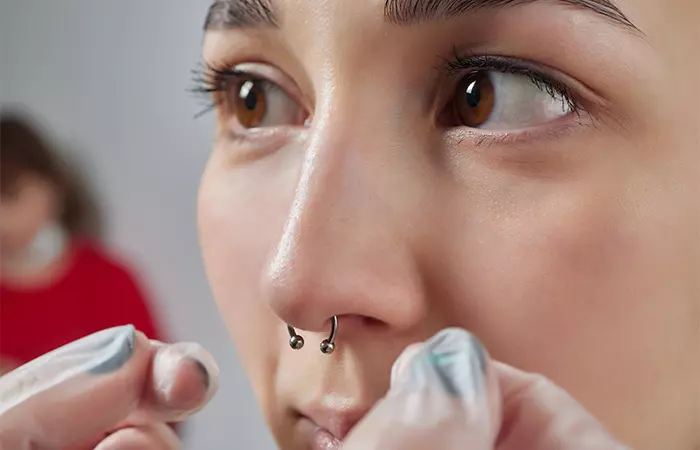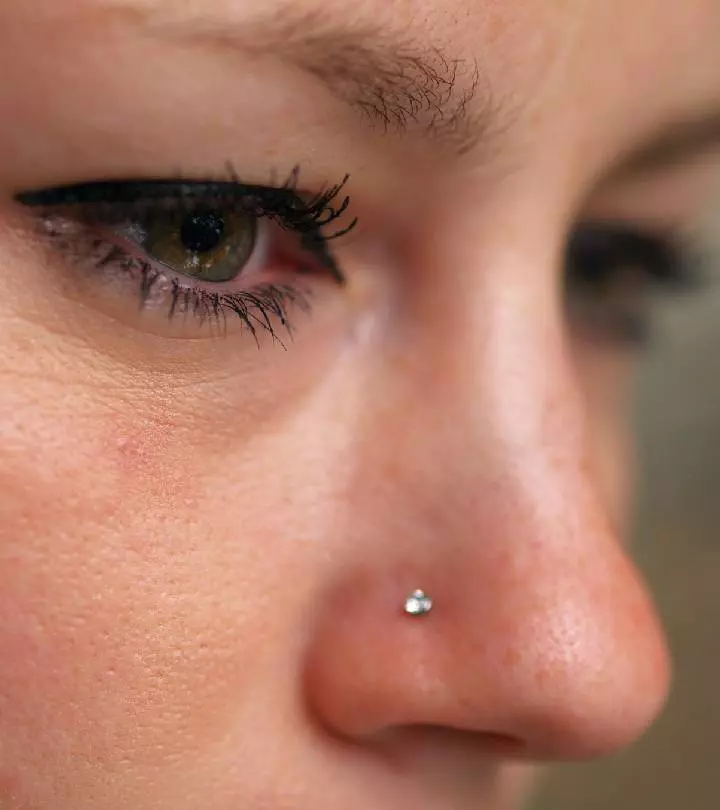Septum Piercing: Everything You Need To Know In 2025
Get prepped up for an adventure and flaunt your unique personality in style.

Image: Shutterstock
The septum piercing is one of the most popular piercings trending today. Many A-list celebrities such as Zendaya, Bella Thorne, and Zoe Kravitz have rocked it on the red carpet, which has only added to its huge popularity. If you want a piercing that exudes a chic vibe, the septum piercing is your answer. In this article, we discuss how to prepare for it, how long it takes to heal, aftercare methods, and everything important you need to know before getting it. Scroll down to learn more!

 Piercing Guide: Septum Piercing
Piercing Guide: Septum Piercing- Placement: Septum, a cartilage that separates the the nostrils
- Best Jewelry: Circular barbells, rings, and CBRs
- Cost: $40 to $90
- Pain Level: Moderate
- Healing Time: 6 to 8 weeks
In This Article
What Is A Septum Piercing?
A piercing that goes through the septum of the nose, i.e., the area between nostrils is called a septum piercing. A needle is used to pierce into the thin piece of skin between the cartilage of the septum and the tip of the nose, which is why it is also popularly referred to as “the sweet spot” by piercers. Typically, a piece of jewelry such as a ring, a hoop, a horseshoe, or a bar is used to adorn a septum piercing.
 Trivia
TriviaExploring the possibility of getting a septum piercing naturally leads one to consider the associated cost. Check out the next section to find out how much it might cost.
Key Takeaways
- A piercing that goes through the septum or the area between nostrils is called a septum piercing.
- Surgical stainless steel, gold, and hypoallergenic metals are ideal for new piercing jewelry, as they do not irritate the skin and ensure proper healing.
- A septum piercing can take around 6-8 weeks to heal under optimum conditions. Follow the aftercare tips suggested by the piercer for safe healing.
How Much Does It Cost To Get A Septum Piercing?

The cost of a septum piercing usually ranges between $40 to $90. However, various factors impact the cost. Some of them are as follows:
- Location Of The Piercing Studio: Piercing studios are likely to be in urban areas. Those in more upscale neighborhoods may be pricier.
- Type Of Jewelry: High-quality materials such as titanium or gold add to the overall cost of the piercing compared to standard options in stainless steel.
- Experience Of The Piercer: Highly experienced piercers command a premium fee due to their reputation for quality work.
- Additional Services: Some studios may offer additional services such as aftercare products, consultations, or follow-up appointments, which can contribute to the overall cost.
Apart from the cost, understanding the necessary preparations for it ensures a well-informed approach to this form of body modification. Check out the section below to know more.
How Do You Prepare For A Septum Piercing?
Preparing for your septum piercing simply involves following certain steps before the actual procedure to ensure a smooth and comfortable experience. Here are some essential tips to keep in mind before your appointment:
- Prioritize research to find a reputable salon with a licensed professional piercer. Visit the salon to ensure they follow hygiene guidelines before scheduling an appointment.
- If you are susceptible to colds or allergies, consider timing your appointment accordingly. Avoid the flu season for optimal comfort and healing.
- Do not go for a septum piercing if you have a runny nose or any form of nasal congestion.
- Stay hydrated and drink plenty of water before your appointment to minimize discomfort during the piercing process.
- Eat well before your appointment as undergoing a piercing on an empty stomach may induce nausea or dizziness.
 Did You Know?
Did You Know?You learned how to prepare for a septum piercing, but you may still be wondering how it is done. The next section reveals that.
How Is A Septum Piercing Done?

Much like any other piercing, a septum piercing is done in steps. Let us take a look at them below.
1. Initial Cleaning And Sterilization: The piercing site and all equipment are thoroughly cleaned and sterilized to ensure hygiene.
2. Jewelry Selection And Sterilization: Once you choose the jewelry, ensure it will be sterilized to minimize the risk of infection.
3. Precise Marking: A surgical marker is used to precisely mark the location on the septum to ensure accuracy.
4. Applying Numbing Agent: The piercer will apply a numbing cream to reduce discomfort during the piercing.
5. Piercing Procedure: Using a sterile hollow needle, the piercer will carefully create a piercing hole through the marked location on the septum with a swift and precise motion.
6. Jewelry Insertion: Once the piercing is made, the selected jewelry is gently inserted into the newly pierced septum.
Usually, cartilage piercings are painful and may make you tear up. Learn more about septum piercing pain level in the next section.
Septum Piercing Pain Level
The pain involved in a septum piercing is generally moderate if it is done correctly and is often rated 5-6 on a scale of 10. While individual pain tolerance varies, the discomfort is typically brief and manageable. Factors such as the skill of the piercer and the use of numbing agents can influence the intensity of pain experienced during the procedure. However, Proper aftercare practices, including cleaning and avoiding irritation are crucial for minimizing any lingering discomfort and promoting optimal healing.
Penny, a blogger, wrote about her septum piercing experience. She answered a few common questions related to septum piercing and said, “I’m not going to lie. It hurts. You are not aware how many times you hit your nose until you pierce it. I got headbutted into the nose at one point which almost caused me blackout pain. However after about two/three weeks – the pain is minimal and doesn’t really worry you (i).”
As you assess how much a septum piercing might hurt, you might also wonder how long it takes to heal. Check it out in the section below.
How Long Does A Septum Piercing Take To Heal?

How long does a nose piercing take to heal? Roughly, 4 weeks. But not if the piercing is in the septum. Septum piercings take 8 to 12 weeks to heal completely when you follow proper aftercare practices. Healing progression may fluctuate, with intermittent phases of apparent recovery followed by periods of redness and discomfort. It is advisable to consult with a professional piercer before considering any premature jewelry changes as it could potentially lead to complications and prolong the healing process.
To ensure complete healing, one must diligently follow an aftercare routine. Check out the next section to find out some crucial aftercare tips.
Septum Piercing Aftercare
Proper aftercare is crucial to ensure the piercing heals without untoward complications. Here are some essential tips to keep in mind (1):
- Before touching your piercing, it is essential to wash your hands thoroughly. This helps prevent the introduction of bacteria into the piercing site.
- Soak a cotton swab in a sterile saline solution and gently clean the piercing area. Leave the solution on for 5-6 minutes before rinsing it with lukewarm water. Repeat this process 1-2 times per dayto keep the piercing clean and promote healing.
- Refrain from using alcohol-based cleansing products on the piercing. These products can be too harsh and may irritate the delicate skin around the piercing.
- Avoid using beauty and personal care products in and around the piercing area. These products may contain ingredients that may irritate the skin or interfere with the healing process.
- Stay out of pools, hot tubs, saunas, and similar environments until the piercing has fully healed. These settings can harbor bacteria and increase the risk of infection.
- Do not attempt to change your nose jewelry until the piercing has completely healed and unless the piercer gives you a go ahead. Touching the piercing unnecessarily can disrupt the healing process.
- Before making any changes to your nose jewelry, it is crucial to consult your piercer. They can guide you when it is safe to change or remove the jewelry without risking infection or complications.
Cleaning the piercing plays a major role in overall healing and aftercare. Check out the following section to learn how to properly clean your septum piercing.
How To Clean A Septum Piercing
Cleanliness is close to godliness. And in this case, it keeps you safe from complications you do not want to deal with after a septum piercing. Follow these steps to properly clean the septum piercing (1).
- Wash your hands thoroughly with soap and water before touching your piercing.
- Prepare a saline solution by mixing 1/4 teaspoon of non-iodized sea salt with a cup of warm distilled water.
- Soak a cotton ball or pad in the saline solution until it is fully saturated.
- Gently clean around the piercing area, removing any crust or debris with the soaked cotton ball.
- Rinse the piercing with warm water to remove any remaining saline solution.
- Pat the area dry with a clean paper towel or allow it to air dry completely.
- Repeat these cleaning stepstwice daily to keep the piercing clean and promote healing.
Cleaning your septum piercing properly is crucial for preventing infections and dead skin buildup and for promoting healing. However, there may be certain risk factors despite cleaning regularly. Check out the next section to know what they are.
Risk Factors Of A Septum Piercing
Despite being a popular choice for self-expression, septum piercings come with their own set of considerations. By familiarizing yourself with these risks, you can make informed decisions regarding your piercing journey. These risks include:
1. Infections
There is a chance of the piercing getting infected if you do not clean properly. Redness, swelling (prolonged swelling that can be distinguished from initial swelling), soreness, and pus or discharge are some signs of infection (2).
2. Blood-BorneDiseases
If the piercing tools are not sanitized and disinfected properly, there is a chance of transmission of blood-borne diseases like hepatitis B or C (3). Make sure you go to an experienced professional who wears gloves, uses sanitized equipment, and has a clean working environment to get your septum piercing.
3. Allergies
There is a chance of an allergic reaction due to the metal of the jewelry. Any metal can cause an allergic reaction, but nickel and cobalt are the most common metal allergens (4). Allergy bumps in the nose are typically minor, although red, scaly skin may surround them.
4. Tearing
The jewelry may get entangled in something, leading to a tear and bleeding.
However, the right choice of materials for your piercing can help minimize a few risks. Let us help you choose the right material for your septum piercing. Check out the next section for more information.
Jewelry Materials Used For Septum Piercing

While various types of jewelry can be used for septum piercing, it is crucial to prioritize materials that will not trigger skin sensitivities or adverse reactions. Opting for high-quality metals can help prevent skin irritation and minimize the risk of infection (5). Take a look at some commonly used materials that prioritize skin sensitivity and infection prevention:
1. Surgical Stainless Steel
Surgical stainless steel is the most popular metal for any kind of nose piercing. It is ideal for a new and healing piercing. Since surgical steel is hypoallergenic, it usually does not bother the skin. It is also reasonably priced compared to other materials.
2. Titanium
Titanium is incredibly long-lasting and biocompatible, which means it won’t affect the skin. It is also extremely durable, lighter than stainless steel, and contains relatively less nickel. Titanium is also scratch-resistant and durable.
3. Gold
Due to its hypoallergenic and pure nature, solid gold is one of the best metal choices for a septum piercing. However, only 14k or 18k real gold should be used. Gold is also a more expensive option than the others.
Tips To Choose The Right Jewelry Material And Size
- Opt for jewelry that fits your septum comfortably without being too tight or too loose. Your piercer can help measure your septum accurately to determine the ideal size for your piercing.
- Explore different styles of septum jewelry, including captive bead rings, seamless rings, septum clickers, or circular barbells to find a look that suits your personal taste and aesthetic preferences.
- Pay attention to the gauge size of the jewelry, which is the thickness of the metal. A thicker gauge provides a more defined look but may require stretching the piercing, while a thinner gauge offers a delicate appearance.
- Opt for septum jewelry with smooth, rounded edges to prevent irritation and discomfort. Avoid sharp edges or rough textures that can irritate the delicate nasal tissue.
- If you have known allergies to certain metals, prioritize hypoallergenic options to minimize the risk of an allergic reaction. Look forjewelry options labeled as nickel-free or specifically designed for sensitive skin.
- Choose high-quality materials that are durable and resistant to corrosion. Quality jewelry may require a higher upfront investment but will last longer and retain its appearance over time.
When selecting the right material and size for your septum piercing, it is essential to consider the types of jewelry available. Each type offers different options in terms of material and size, allowing you to find the perfect fit for your style and comfort.
Types Of Jewelry Used
- Circular Barbells: These are horseshoe-shaped with threaded beads on each end, creating a circular appearance when worn.
- Captive Bead Rings (CBRs): These rings have a small bead or ball that is held in place by the tension of the ring’s ends, creating a seamless look.
- Clickers: Clickers are hinged rings that click shut, making them easy to insert and remove. They often feature decorative elements such as gemstones or intricate designs.
- Seamless Rings: Seamless rings have a continuous loop with no openings or seams, providing a sleek and minimalist aesthetic.
- Septum Retainers: These are simple, straight pieces of jewelry designed to be discreet and are a popular option. They are often used during the healing process or for situations where a more subtle look is desired.
As there are many stylish options available, one may usually opt for changing the jewelry to flaunt their style. However, it is very crucial to know when to change the jewelry. The next section takes you through the ins and outs of it.
When To Change A Septum Piercing Jewelry
Knowing when to change septum jewelry is essential for maintaining its health and appearance. It is generally recommended to wait until the piercing has fully healed, which typically takes around 6 to 8 weeks before you change the jewelry. Changing the jewelry too soon can disrupt the healing process and increase the risk of infection or irritation. Once the piercing has healed and once your piercer gives you the go-ahead, you can consider changing the jewelry to suit your style or preference. Always follow proper hygiene practices and consult with your piercer if you have any concerns or questions about changing your septum piercing jewelry.
Once the piercing heals completely, it is beneficial to know how to change the jewelry yourself. Check out the next section to learn how to do that.
How To Change A Septum Piercing –Expert Insights
, MD, recommends the following routine:
- 6-8 weeks after getting the piercing, the septum part of the nose will heal and loosen up enough to change the jewelry easily.
- Sanitize your hands and the septum jewelry, and keep cotton balls and a disinfection solution ready.
- Place one end of the septum jewelry near your piercing facing up.
- Carefully insert the end of the jewelry into the piercing.
- If locating the piercing hole becomes a challenge, try lifting the side of your nose or pinching below your septum and pulling it down to see where it is.
- Put your finger on the other side of the hole so that you can feel the end coming through.
- Pull the end completely through the piercing and adjust the jewelry until it is symmetrical on either side of your septum.
A septum piercing is more than just a fashion trend. While it definitely makes you stand out in the crowd, it demands commitment to proper aftercare practices. You must get it done by a reputable and experienced piercer and follow the dos and don’ts suggested by them to avoid the risk of infection and piercing rejection. Also, do not hesitate to reach out to them if your piercing takes longer than usual to heal and you experience pain. Ensuring proper care and keeping an eye out for signs of infection will help you embrace this timeless body modification and flaunt your style.
Frequently Asked Questions
Does a septum piercing hurt after?
Yes, your septum piercing may be tender for a week after the piercing. This is normal and nothing to worry about.
Is a septum piercing unprofessional?
This may depend on the workplace. Some workplaces may not have an issue with a septum piercing while some offices may.
What hurts more – nostril or septum piercing?
A nostril has more nerve endings than a septum. This may make a nostril piercing more painful than a septum piercing. However, keep in mind that it also depends on the pain tolerance of the individual.
At what age can you get a septum piercing?
This may depend on the studio. Some studios allow people aged 14 and above with a parent to get a septum piercing. Other studios may set the age limit at 18 or above.
Can you shower with a septum piercing?
Yes, you can shower with a septum piercing. However, avoid exposing the septum piercing to water and soap containing harsh chemicals to prevent hurting the wound ad delaying the healing.
Do septum piercings lift your nose?
No, a septum piercing does not change the size or shape of your nose in any way.
If you are curious about the septum piercings, this video is for you. Watch how a septum piercing is performed in this video. Discover why the client chose to get a septum piercing, the process, and her personal experience with it.
Personal Experience: Source
StyleCraze's articles are interwoven with authentic personal narratives that provide depth and resonance to our content. Below are the sources of the personal accounts referenced in this article.
(i) I LOVE MY SEPTUM PIERCING. FACT.https://www.blogger.com/blogin?u=https://www.blogger.com/blogin?u=https://misspennydreadful.blogspot.com/2013/05/i-love-my-septum-piercing-fact.html
References
Articles on StyleCraze are backed by verified information from peer-reviewed and academic research papers, reputed organizations, research institutions, and medical associations to ensure accuracy and relevance. Read our editorial policy to learn more.
- Suggested aftercare for body piercings
https://safepiercing.org/aftercare/ - Complications and hazards associated with body piercing: A narrative review
https://pubmed.ncbi.nlm.nih.gov/37916624/ - Transmission of hepatitis B and C virus infection through body piercing
https://www.ncbi.nlm.nih.gov/pmc/articles/PMC5058954/ - Immunological mechanisms of metal allergies and the nickel-specific tcr-pmhc interface
https://www.ncbi.nlm.nih.gov/pmc/articles/PMC8535423/ - Jewelry material
https://safepiercing.org/jewelry-for-initial-piercings/
Read full bio of Bianca Lorena Saldes
Read full bio of Monomita Chakraborty
Read full bio of Eshna Das
Read full bio of Swathi E


























Community Experiences
Join the conversation and become a part of our empowering community! Share your stories, experiences, and insights to connect with other beauty, lifestyle, and health enthusiasts.